The Common Tailorbird, Orthotomus sutorius, is a small warbler whose range extends from India to southern China and down into Indonesia. It is common, mostly in the lowlands, but can range as high as 5000ft. It is found in most habitats with thick cover and can often be found in urban parks and gardens.
It is an active bird that seldom stays still or quiet and often cocks its tail as it moves about through the thick cover. This individual was seen in Hong Kong and the comparatively short tail suggests that she may be female. The males have long central tail feathers in their breeding plumage which would be attained by early March in readiness for the season. Otherwise, sexes are alike. Her behaviour was at odds with what I have seen before. She was on the ground in an open area with only sparse cover, feeding at the entrance of crab(?) holes and allowed me to get very close.
It’s song was nicely summed up by Rudyard Kipling in Rikki-tikki-tavi, where the tailorbird Darzee continually and irritatingly chirps on without thought given to the content of the piece. “Nag is dead..is dead..is dead.” Kipling also makes the suggestion that tailorbirds trail a wing to feign injury, but this remains anecdotal and has not been proven. As it happens, this individual did display this behaviour, trailing her left wing, but as she allowed me to approach so closely and when she did fly, she did so weakly, it’s possible that she actually was injured. On close inspection of the photographs, her left eye appeared infected.
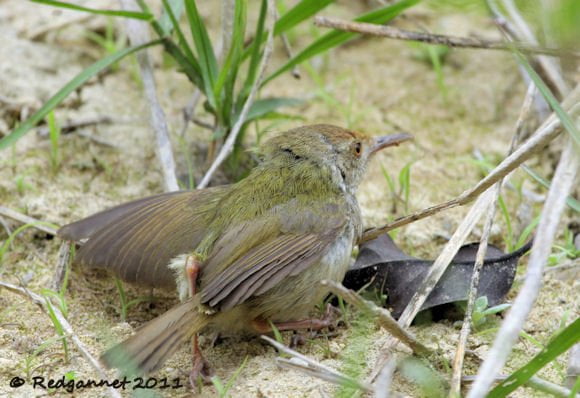
The bird is named for its habit of sewing two leaves together to make a cup in which it builds its nest. The latin binomial means ‘straight-edged cobbler’, which may be a closer description of how it constructs its nest-bearing cup. It uses its bill to make holes in the leaves as a shoe-maker might use his awl to pierce leathers before sewing or tacking them together. The tailorbird uses spider’s silk, grass or tiny twigs as threads, tacking material or even rivets.
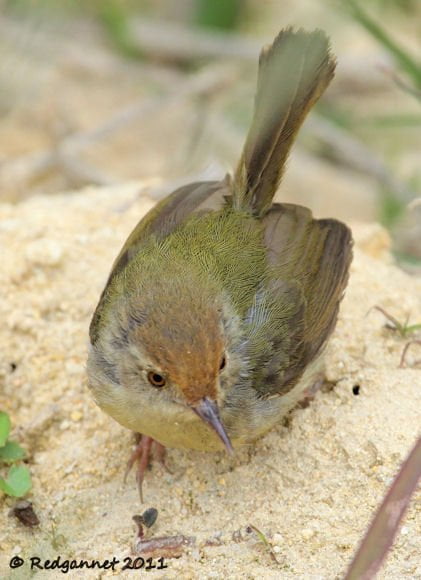
For a three-part trip report to Hong Kong, including the Common Tailorbird and visits to sites at Tai Mo Shan, Cheun Lung Family Walk, and Aberdeen Reservoirs follow the links or visit Redgannet.
If you liked this post and want to see more great images of birds make sure to check out 10,000 Clicks, our big (and growing) page of galleries here at 10,000 Birds.
This post has been submitted to Bird Photography Weekly #136. Go check it out!

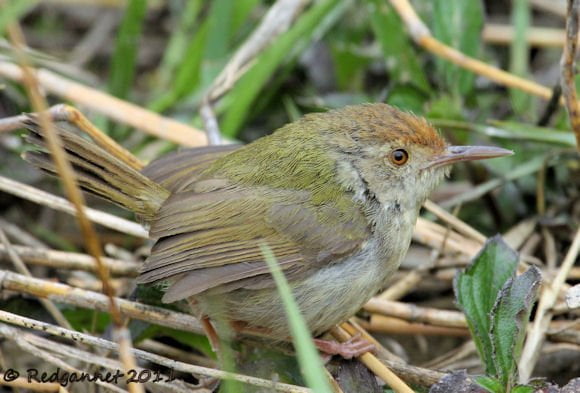
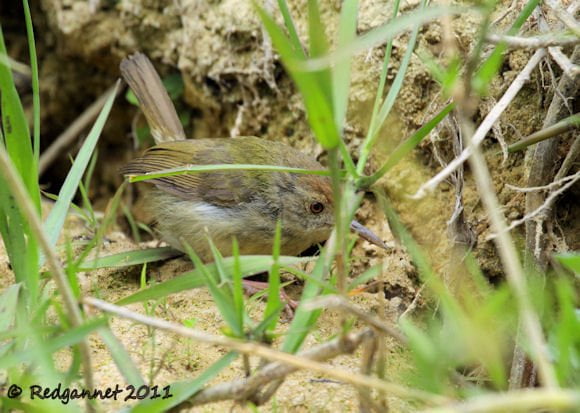
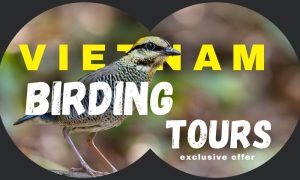









Bravo!
Love learning about birds I can only hope to see. Great images and information!
Very active, adorable little birds.I was fortunate to photograph and film some juveniles sometime back this year.
They are attractive little birds that I always enjoy seeing in Asia.
Very interesting post.. How cool is it that the bird “sews” its nest. Great photos 🙂
Great series on an interesting bird!! Boom & Gary of the Vermilon River, Canada.
Lovely images and info of a beautiful little bird.
I just love that first image!
Her coloring is so warm – her green feathers contrasting with her brown head. Such a lovely little bird.
Thanks for sharing!
Everyone seems very taken with the Tailorbird. Indeed it is a very endearing bird with a penetrating song and a cheeky manner. It is not usually as approachable as the individual above, preferring to call from tangles and show briefly. I was lucky to find this one out in the open.
@ Carletta, I am making an assumption about her being a female. The longer central tail feathers that would indicate a breeding male were not present, but that does not discount the possibility of a late developer.
The sexes are the same apart from the tail feathers.
Great photos and a beautiful bird. It does have pretty coloring.
SO Interesting—and it reminds me of the wrens we have around here except for the color of course–they have similiar behaviors as you described. Great Photos!!
Very awesome photos…visiting from Bird Photography…
Awesome. A true close encounter! The detail is phenomenal, It looks like you could climb on her back and fly away. Sad to say I have never seen a warbler in “real” life. These captures and your wonderful text is a revelation!
What an interesting little bird! Wonderful photos and good info in your post!
Interesting bird! With its tail up and its curved beak it reminds of a wren, specifically the Carolina Wren. But it’s probably just coincidence, or convergent evolution?
A lovely little bird — wonderful capture!
cute birdie nice feathers
BRAVO!!!!!
I love birds i hate you xD
thats soo awesome they are fluffy!!
this was awesome it really helped me with a report and i also liked how they build their nests.